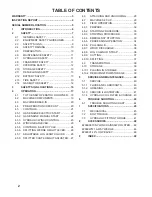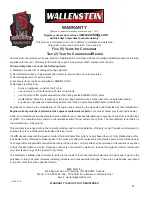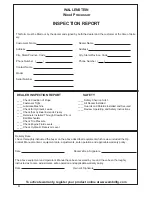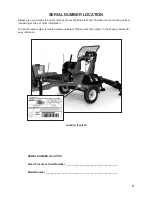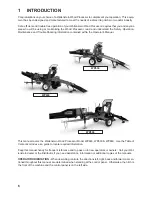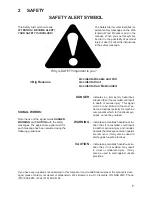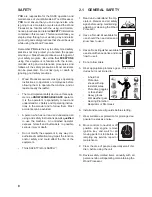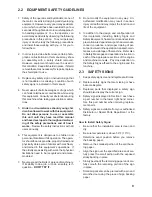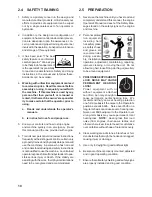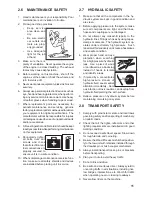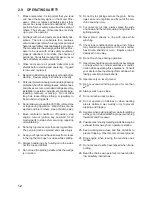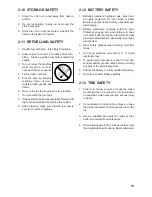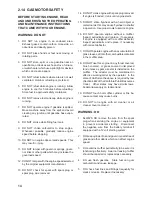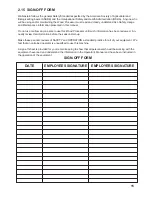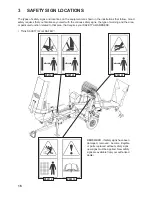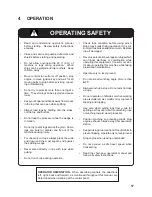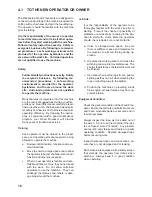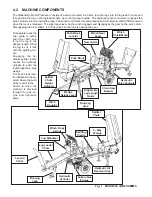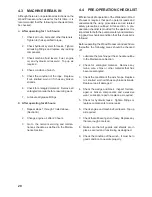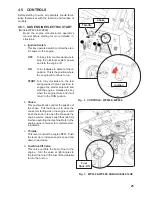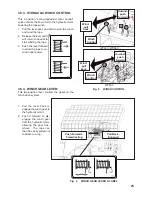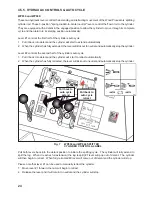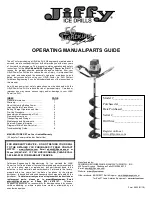
9
2.2 EQUIPMENT SAFETY GUIDELINES
1.
Safety of the operator and bystanders is one of
the main concerns in designing and developing
equipment. However, every year many accidents
occur which could have been avoided by a few
seconds of thought and a more careful approach
to handling equipment. You, the operator, can
avoid many accidents by observing the following
precautions in this section. To avoid personal
injury or death, study the following precautions
and insist those working with you, or for you to
follow them.
2. In order to provide a better view, certain photo-
graphs or illustrations in this manual may show
an assembly with a safety shield removed.
However, equipment should never be used in
this condition. Keep all shields in place. If shield
removal becomes necessary for repairs, replace
the shield prior to use.
3. Replace any safety sign or instruction sign that
is not readable or is missing. Location of such
safety signs is indicated in this manual.
4. Never use alcoholic beverages or drugs which
can hinder alertness or coordination while using
this equipment. Consult your doctor about using
this machine while taking prescription medica-
tions.
5.
Under no circumstances should young chil-
dren be allowed to work with this equipment.
Do not allow persons to use or assemble
this unit until they have read this manual
and have developed a thorough understand-
ing of the safety precautions and of how it
works.
Review the safety instructions with all
users annually.
6. This equipment is dangerous to children and
persons unfamiliar with its operation. The opera-
tor should be a responsible, properly trained and
physically able person familiar with machinery
and trained in this equipment's operations. If
the elderly are assisting with work, their physical
limitations need to be recognized and accom-
modated.
7. Never exceed the limits of a piece of machinery.
If its ability to do a job, or to do so safely, is in
question -
DON'T TRY IT.
8.
Do not modify the equipment in any way. Un-
authorized modification may result in serious
injury or death and may impair the function and
life of the equipment.
9.
In addition to the design and configuration of
this implement, including Safety Signs and
Safety Equipment, hazard control and accident
prevention are dependent upon the awareness,
concern, prudence, and proper training of per-
sonnel involved in the operation, transport, main-
tenance, and storage of the machine. Refer also
to Safety Messages and operation instruction in
each of the appropriate sections of the engine
and machine manuals. Pay close attention to
the Safety Signs affixed to the engine and the
machine.
2.3 SAFETY SIGNS
1. Keep safety signs clean and legible at all times.
2. Replace safety signs that are missing or have
become illegible.
3. Replaced parts that displayed a safety sign
should also display the current sign.
4. Safety signs displayed in Section 3 each have
a part number in the lower right hand corner.
Use this part number when ordering replace-
ment parts.
5. Safety signs are available from your authorized
Distributor or Dealer Parts Department or the
factory.
How to Install Safety Signs:
• Be sure that the installation area is clean and
dry.
• Be sure temperature is above 50°F (10°C).
• Determine exact position before you remove
the backing paper.
• Remove the smallest portion of the split back-
ing paper.
•
Align the sign over the specified area and care
-
fully press the small portion with the exposed
sticky backing in place.
• Slowly peel back the remaining paper and care-
fully smooth the remaining portion of the sign
in place.
• Small air pockets can be pierced with a pin and
smoothed out using the piece of sign backing
paper.


